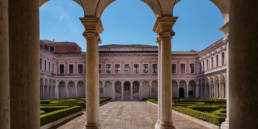This article is by Claudia Cappo, a volunteer who is helping a group of Cinque Terre grape growers to raise funds for the maintenance of dry stone walls (click here for the crowdfunding). This theme is a particular passion of mine and I am doing what I can to help: these walls are what hold up the Cinque Terre and protect the villages below from landslides. Her hands-on story is moving. Please read it. — Alexandra
Once upon a time, I was simply a visitor to the Cinque Terre—now they can’t get rid of me. On my first trips to the area, I didn’t give much thought to the vineyards that I passed on my hikes between the villages. Little did I know that this area was declared a UNESCO World Heritage Site thanks in large part to its unique, man-made terraced landscape. Everything changed for me when I met a local winemaker, Riccardo Fino, through mutual friends in Riomaggiore. It was in his vineyard that I discovered the true essence of the Cinque Terre: its humble yet majestic dry stone walls.

I wanted to learn Riccardo’s winemaking story, and I didn’t mind getting my hands dirty in the process. On the first day that I volunteered in his vineyard, I was handed a pair of work gloves and a bucket. My assigned task was to gather medium-sized stones on the far side of the vineyard and haul them to a designated pile near the collapsed wall that was to be rebuilt. This was my introduction and warm welcome to “Wall Building 101.” There were plenty more days to come. Within just a few short weeks my work ethic, curiosity, and eagerness to help transcended the language barrier and a friendship and bond developed with Riccardo.
After weathering over a century of rain and sun, a large section of dry stone wall in I Magnati’s vineyard had fallen. Riccardo and his business partner, Davide, assessed the remaining intact portions of the wall to determine the area we would be working within. The next few days were dedicated to the tedious task of pulizia (cleaning) which entails removing the stones and dirt from the collapsed wall. There is no waste in the vineyard: everything that is pulled from the wall—from small stones to large stones and even the dirt itself—is hauled away and separated into distinct piles where it waits to be repurposed. The large stones were carried on our backs while the smaller stones were hauled by hand, bucket after endless bucket. We weaved back and forth across the vineyard from the fallen wall to our piles of sorted materials. We found our own harmonious rhythm: Riccardo shoveled dirt and smaller stones into the bucket that I would then carry down to the terrace below. Once there, I’d empty the contents, sift the stones from the dirt, and start all over again. Weighing in at 8-10kg per filled bucket, the bending, lifting, dumping and sorting was physically demanding. I did my best to keep up with Riccardo’s pace. I’m determined and stubborn by nature; rather than give up, I scooted an extra empty bucket over for him to fill. Hauling twice the load? That’s what I call maximizing efficiency!

The backbreaking work was rewarded with intermittent moments of breathtaking beauty and reflection. The panoramic vistas of this region are truly one-of-a-kind. As I helped to rebuild these walls, I felt connected to—and a deep sense of appreciation for—the ancestors of the Cinque Terre who terraced this land with over 3,500 miles of dry stone walls. Despite being bone tired, I’d smile. But the vineyard is no place for daydreaming. A misplaced foot can crush a growing vine, or it can lead to a slip and fall. It was back to work for me until the job was done.

Once the collapsed wall had been cleaned to its base the rebuilding could finally begin. But wait! I soon learned that within each dry stone wall there is actually an additional interior wall that needs to be built first for added support. In the rebuilding of both layers of the wall, small rocks and sifted dirt are used instead of cement (which is why they are called “dry stone”). This traditional method for building walls, which has been used for nearly a millennium in the Cinque Terre, provides strength and structure but it also allows rainwater to flow through the wall. The dry stone technique ensures that not only water but also the natural movement of the mountain are not stronger than the wall.
It was finally time for all of the previously separated stones and dirt to be used again. Smaller stones that were longer in shape were wedged in the empty space between the large stones. The largest, heaviest and prettiest stones were carefully chosen to form the wall’s exterior which was built out and away from the earth.

Working in the vineyards of the Cinque Terre is no joke; Riccardo and Davide labor like machines. With no space on the terraces for equipment, I was astounded by what they could accomplish with their own hands, a few tools, and a wheelbarrow. Maintaining the walls is a job that must be done every year as different sections will require repair. I now see why winemaking is a dying trade in this region: one has to be stubborn and passionate as hell to do this.
I can vividly recall a specific moment after a long day of wall building. Riccardo and I were covered in dirt, so much so that it was even in our nostrils. He looked me square in the eye and said, “Now you see what it takes to make one glass of wine in the Cinque Terre.” You won’t hear complaints from me. You’ll only see me grinning and you might hear an occasional request for the wall to come to me instead of the other way around (mostly as I’m lugging a heavy stone on my back).

I am no longer that oblivious visitor to the Cinque Terre; I’m very aware of the bigger picture. Maintaining the dry stone walls protects the terraces that provide the only farmable land here; if the walls are not maintained they will eventually collapse and can spur a domino effect of damage to the terraces and hillside below. When the land is abandoned and the walls are not repaired, there is no structural support in place to mitigate nature’s wrath—landslides become a very real possibility. The winemakers that farm the terraces of the Cinque Terre not only maintain the dry stone walls and this area’s agricultural roots, but they also help to keep the villages safe. Without these walls, Riccardo predicts that there would be no Cinque Terre. I believe him.
While away from the Cinque Terre this Fall, I received news that the area had been hit with heavy rains. I didn’t need to ask if walls had collapsed, I knew without being told. What I did ask Riccardo was, “How many? When do you need me?” The walls and vineyards I once overlooked now call to me. Sometimes I even hug them. These walls are arduous labors of love that make life in the Cinque Terre possible. One thing is for certain: there are a pair of work gloves and a wall in the Cinque Terre that await my return.
Crowdfunding to rebuild the dry stone walls of the Cinque Terre
Claudia, the author of this article, is part of a group of volunteers who are helping Riccardo, Davide and other Riomaggiore winemakers raise funds to rebuild over 24k square feet of damaged walls in their terraced vineyards. Rewards include Cinque Terre experiences, and even a day’s work on the walls, if you are up to it!
Find out more and get involved at: https://igg.me/at/grapesandheroes
Sign up to receive future blog posts by email
Related Posts
September 11, 2023
An art historian’s approach to things to do in Naples, Italy
June 22, 2023
4 day trips from Palermo up the Tyrrhenian coast
September 20, 2021




